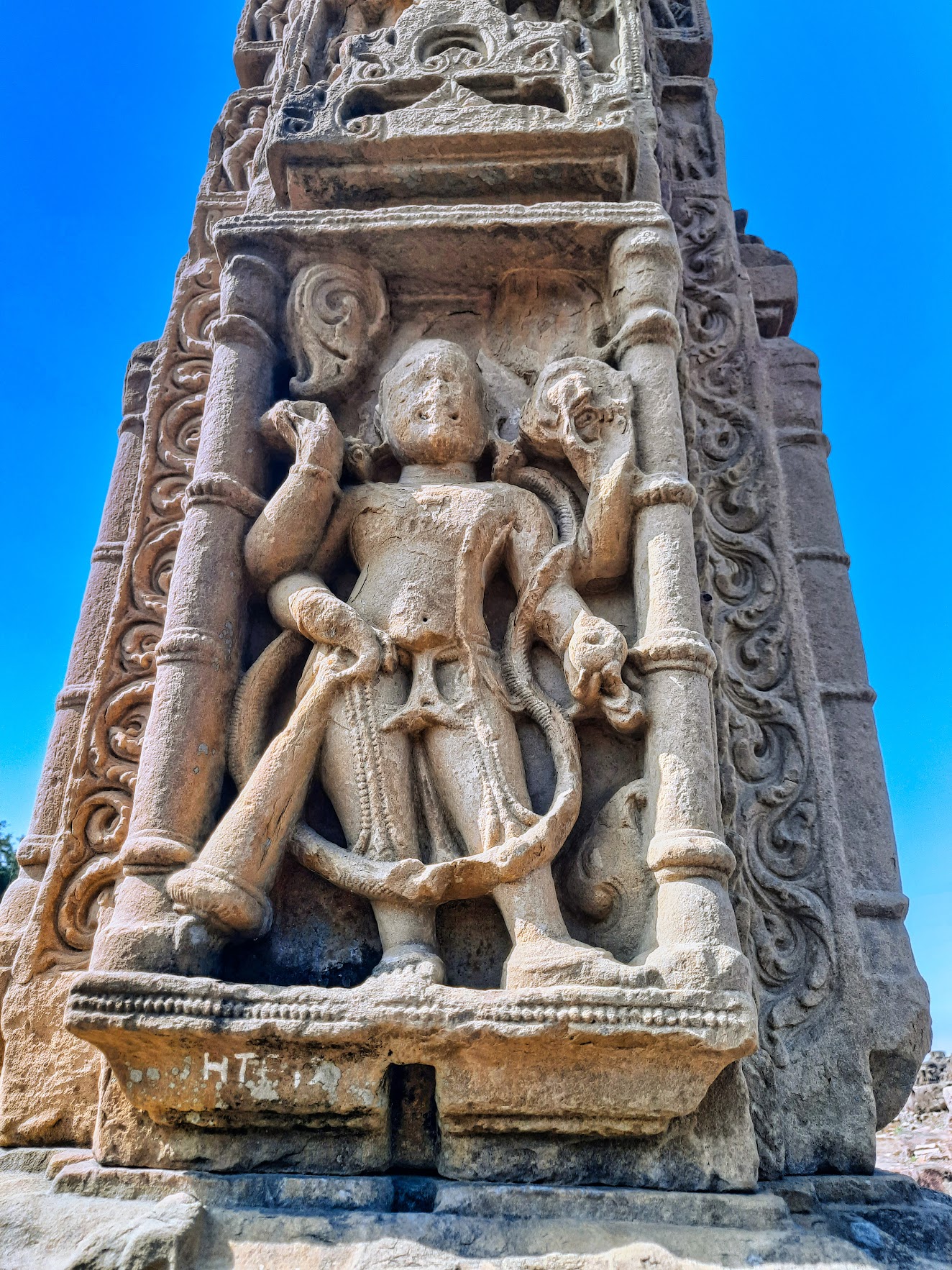When travelers think of temple architecture in Madhya Pradesh, places like Khajuraho or Bhojpur often dominate the conversation. Yet tucked away in Vidisha district lies Gyaraspur, a small town with a surprisingly large legacy. Here, amidst rolling hills and quiet countryside, stand a series of ancient temples—many dedicated to Lord Shiva—that reveal how Central India once thrived as a hub of spiritual and artistic expression.
Visiting Gyaraspur Shiva Temples is like stepping back into the 9th and 10th centuries, when dynasties like the Pratiharas, Paramaras, and others were experimenting with temple design that fused devotion with exquisite craftsmanship. The Shiva shrines here are not only places of worship but also markers of history, telling stories through stone carvings and layouts that have weathered centuries.
Setting the Scene Gyaraspur Shiva Temples
Gyaraspur is about 35 kilometers from Vidisha and roughly 60 kilometers from Bhopal, making it an easy day trip if you’re in central Madhya Pradesh. The drive itself sets the mood—you leave behind busy town centers and enter landscapes filled with fields, streams, and small hamlets. By the time you arrive, the silence of the area immediately contrasts with the grandeur of the monuments scattered around.
The temples aren’t clustered tightly but spread across the town, almost like open-air chapters of a forgotten history book. Some are relatively intact, while others stand partly in ruins, yet each has a distinct character.
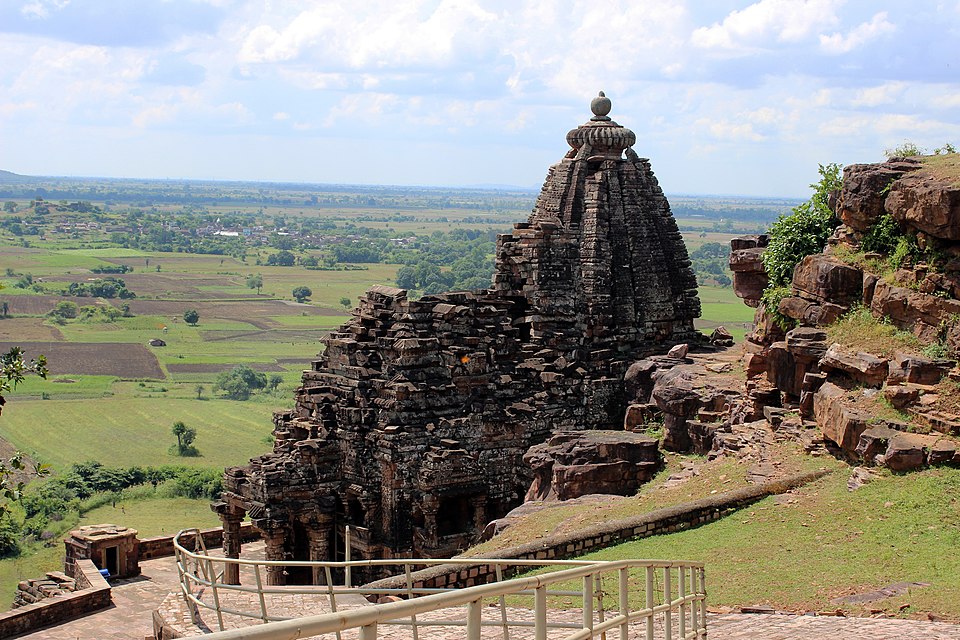
The Shiva Connection
Among the temples at Gyaraspur, many are either dedicated to or associated with Shiva. This is no surprise—during the early medieval period, Shaivism was a powerful force across central India. Temples here typically feature:
- Shiva lingams, some still worshipped today.
- Carvings of Nandi, Shiva’s bull, often facing the sanctum.
- Panels depicting episodes from Shaiva mythology, like Ravana lifting Mount Kailash or Shiva in his cosmic dance form.
One striking feature is how seamlessly the temples combine artistic detail with spiritual functionality. They weren’t built as mere monuments; they were active centers of ritual life, anchoring communities around them.
The Maladevi Temple and Its Influence
While technically dedicated to a goddess, the Maladevi Temple at Gyaraspur often gets mentioned alongside the Shiva shrines because of its architectural influence. Perched dramatically on a hill, it gives you a sense of how temples in this region were envisioned not just as sacred enclosures but as part of the landscape.
Standing here, you can imagine how nearby Shiva temples—smaller but equally intricate—would have complemented the spiritual geography of Gyaraspur.
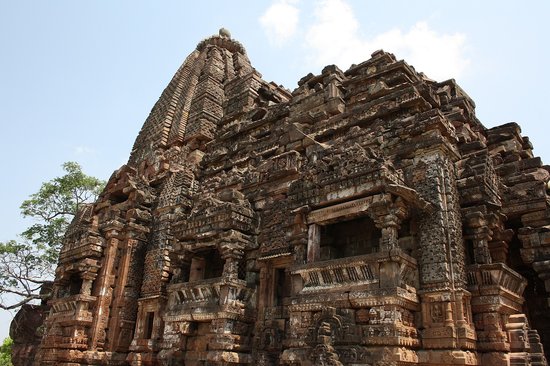
Bajramath and Stepwell Links
Another fascinating aspect of Gyaraspur is the Bajramath Temple, which though Jain in dedication, reflects the same artistic traditions that shaped the Shiva temples. Nearby stepwells and ruined shrines suggest that this town was once a significant pilgrimage stop, catering to multiple faiths.
The Shiva temples stand out because they retain strong ritual continuity. Even if a roof has collapsed or a wall has eroded, villagers still place flowers and lamps before the lingam. The devotion hasn’t died even if the structures bear scars of time.
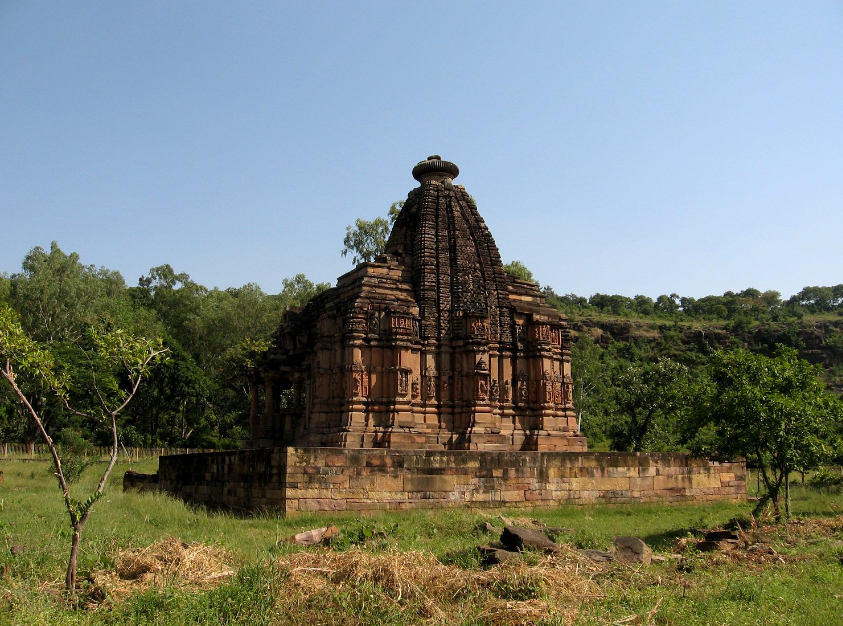
Architectural Highlights
When you first step into Gyaraspur, the air is filled with silence, broken only by birds and the rustling of trees. The temples stand quietly, their stones weathered yet dignified. What makes these shrines special isn’t just their age—it’s the way they carry forward centuries of architectural brilliance. Every pillar, every carved lintel, and every sculpted panel is a lesson in how Central India interpreted the divine through stone.
The Nagara Style Spires
Most of the temples in Gyaraspur follow the Nagara style of North Indian temple architecture. Unlike the towering Dravidian gopurams of the South, Nagara temples rise in a curvilinear spire, or shikhara, that seems to stretch toward the sky.
Standing before these spires, even if some are broken, you can sense their original power. The geometry is both simple and sophisticated—concentric layers of stone narrowing as they rise, almost like waves of energy funnelling heavenward. This was no accident. Ancient architects believed the shikhara was a cosmic ladder, guiding both prayer and spiritual energy upwards.
In the Shiva temples here, these spires once crowned sanctums that housed the lingam. Though parts have collapsed over the centuries, the surviving segments still capture that upward momentum.
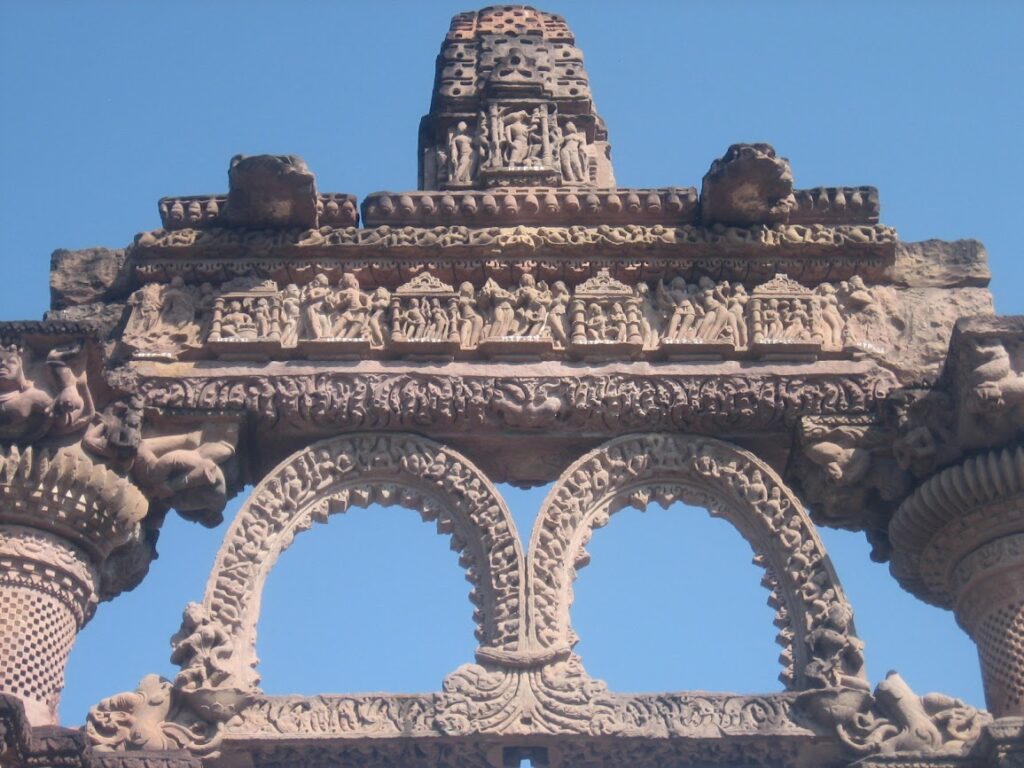
Doorways as Sacred Thresholds
One of the first things you notice when approaching any temple in Gyaraspur is its doorway. Far more than an entry point, it was designed as a ritual threshold—the moment when the visitor leaves behind the ordinary world and steps into the sacred.
At Gyaraspur, these doorways are richly carved with motifs:
- Ganesha, the remover of obstacles, almost always occupies a niche, ensuring every worshipper enters under his protection.
- Shiva and Parvati are often carved together above the lintel, symbolizing divine balance.
- On the jambs, rows of miniature deities, floral scrolls, and celestial figures create a sense of being welcomed into a higher realm.
Run your fingers along the stone, and you can feel how patiently artisans chiseled these forms, each curve and line holding meaning. The passage into the sanctum becomes a journey in itself.
Carvings that Tell Stories
Perhaps the most enchanting part of Gyaraspur’s Shiva temples is the sculptural storytelling. The outer walls serve almost like open books, narrating tales from Shaiva mythology and everyday life.
Look closely, and you’ll find:
- Ravana lifting Mount Kailash, his ten heads straining under the weight while Shiva presses it down with a toe.
- Shiva as Nataraja, caught mid-dance, hair flying, dwarves playing drums at his feet.
- Couples in tender embrace, reminding worshippers that love and fertility are also sacred.
- Hunters, musicians, and dancers, showing how temples celebrated all aspects of life, not just divine stories.
Each panel was deliberately placed, offering pilgrims visual lessons. For many who couldn’t read, these carvings were a way of understanding philosophy and mythology through art.
Nandi and the Lingam
No Shiva temple feels complete without Nandi, the sacred bull, positioned directly facing the sanctum. In Gyaraspur, several temples still preserve this alignment. Even when walls have collapsed, Nandi remains steadfast, a silent guardian gazing eternally at Shiva.
Inside the sanctum, the lingam often rests on a yoni base, symbolizing both creation and cosmic balance. What’s striking in Gyaraspur is how the lingams, though simple in form, feel alive in their setting. The way light falls on them through small openings in the wall, or how devotees still place flowers and oil lamps, creates a sense of continuity—an unbroken line of worship stretching back a thousand years.
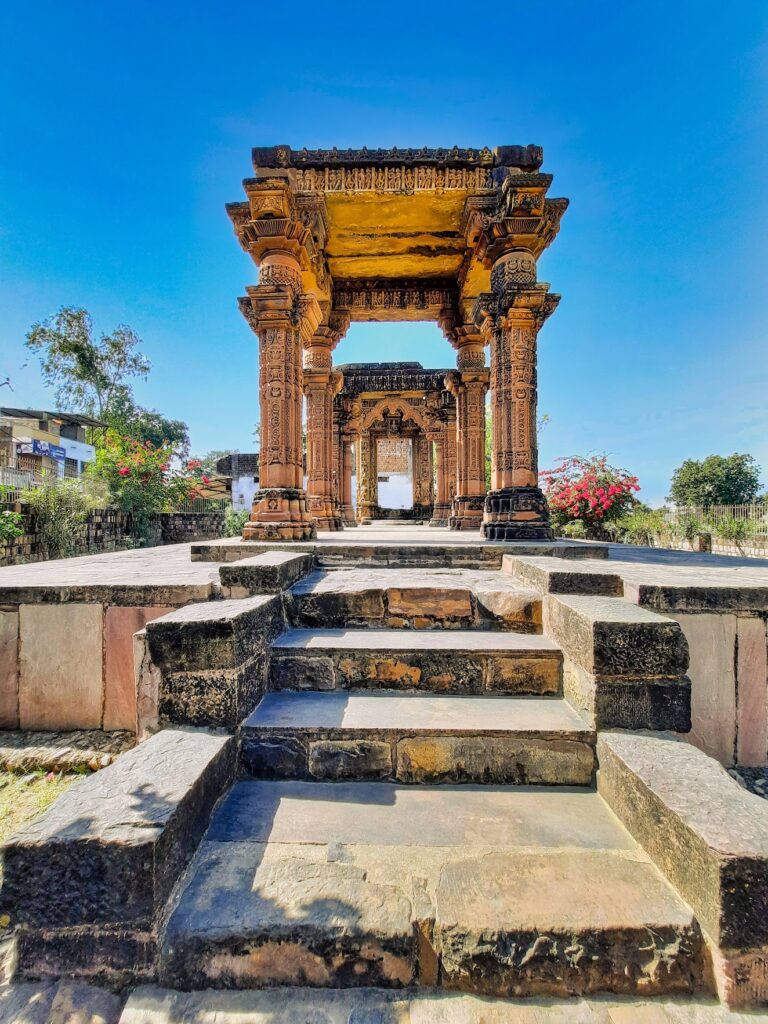
Pillars that Speak of Craft
Walk around the surviving mandapas (pillared halls), and you’ll see the craftsmanship of Gyaraspur’s builders on full display. The pillars here are not uniform; each has its own decorative rhythm. Some are square at the base, octagonal in the middle, and circular at the top—an intentional design choice that adds both strength and beauty.
The capitals often bear lotus motifs, a symbol of purity, while others feature vyalas (mythical lion-like creatures) leaping out of stone. The artisans clearly took pride in variety, making sure no two pillars looked exactly alike.
These mandapas weren’t just architectural necessities—they were spaces where pilgrims gathered, priests recited hymns, and rituals unfolded. Sitting under their shade today, you can almost imagine the hum of voices echoing against the stone.
The Use of Local Stone
Another highlight is the material itself. Gyaraspur’s temples are primarily built of local sandstone, ranging in shades from warm red to golden brown. This choice wasn’t just practical but aesthetic. In the soft glow of morning or evening, the temples radiate warmth, almost as though the stones themselves are alive.
Unlike polished marble or granite, sandstone carries a rugged texture, which makes carvings appear more organic. Even after centuries of weathering, the details still hold remarkable clarity.
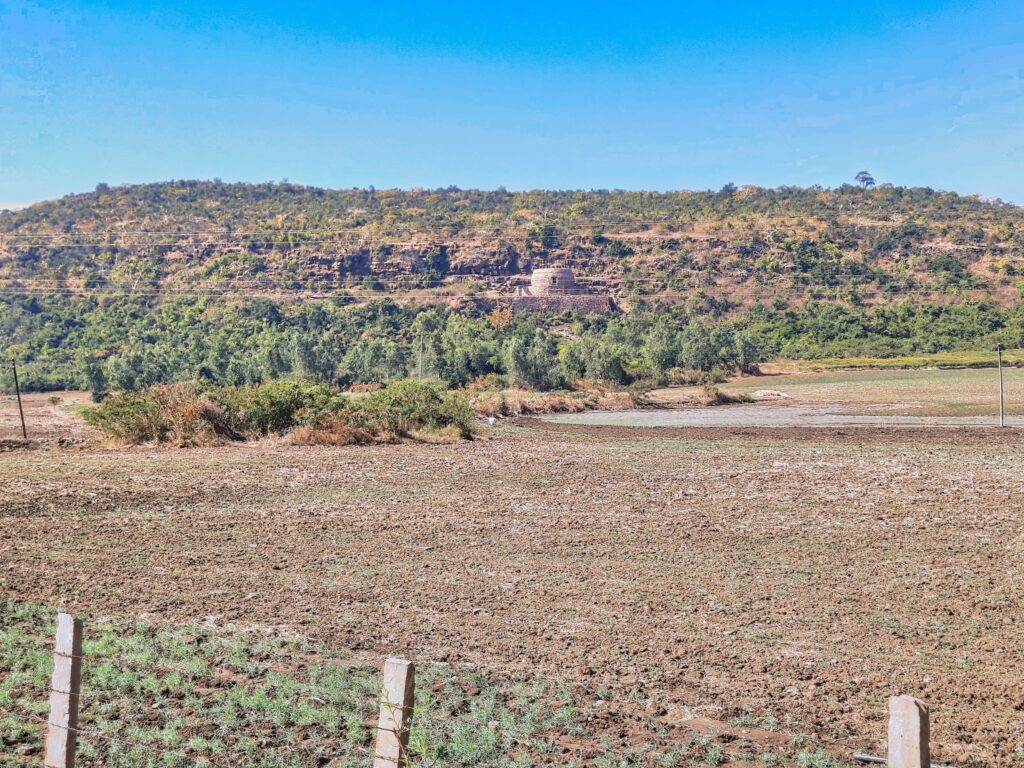
Play of Light and Space
Step into a sanctum at midday, and you’ll notice how carefully architects controlled light. Small openings allow just enough sunlight to fall on the lingam, creating a glowing effect. In contrast, the mandapas are more open, letting in ample light for community rituals.
This play between shadow and illumination wasn’t accidental. It was part of a larger philosophy—guiding the devotee from the brightness of the outside world into the dim, contemplative core where the divine resided.
Ruins That Still Breathe
Some of Gyaraspur’s Shiva temples are partly ruined—walls missing, spires broken. Yet even in decay, the architecture holds dignity. Arches frame the sky, pillars stand like silent sentinels, and scattered carvings lie around like puzzle pieces waiting to be reassembled.
For a traveler, this imperfection adds beauty. You see the endurance of art across centuries of change, reminding you that architecture isn’t static. It evolves, it ages, and yet it continues to inspire.
Comparisons and Distinctiveness
It’s tempting to compare Gyaraspur’s temples with those of Khajuraho, given they share timeframes and regional influences. Yet Gyaraspur’s Shiva shrines feel more intimate and earthy. Where Khajuraho dazzles with abundance, Gyaraspur whispers with subtlety. The carvings here are less flamboyant but deeply grounded, reflecting a community’s devotion rather than royal grandeur.
Why Architecture Here Still Matters
The real highlight of Gyaraspur’s architecture isn’t just the technical brilliance—it’s the human element. These temples were built not for show but for worship, for anchoring communities, for giving people a space to connect with something larger than themselves.
When you stand before these ancient stones, you realize they are more than relics. They are vessels of memory, creativity, and resilience. And that’s what makes the architecture of Gyaraspur’s Shiva temples timeless.
Atmosphere Today
What makes Gyaraspur special is its relative obscurity. Unlike Khajuraho or Ujjain, you won’t find large crowds or ticketed queues. Instead, you may encounter a priest performing a quiet ritual, a shepherd guiding goats past temple walls, or a group of schoolchildren sketching the ruins.
The serenity allows you to sit and absorb the place at your own pace. If you’re someone who enjoys slow travel, Gyaraspur offers that rare chance to feel history without the noise of mass tourism.
Practical Travel Tips
If you’re planning to visit the Gyaraspur Shiva Temples in Madhya Pradesh, you’re already making a choice that most tourists overlook. That’s the beauty of it—these temples don’t attract huge crowds, which means you get the rare chance to explore history in peace. But because Gyaraspur is still a little off the mainstream tourist trail, it helps to prepare well. Here are some practical, down-to-earth tips to make your journey smooth, enjoyable, and memorable.
How to Reach Gyaraspur
Gyaraspur is a small town in the Vidisha district of Madhya Pradesh. Getting here requires a little planning:
- By Air: The nearest airport is Raja Bhoj Airport in Bhopal (around 100 km away). From there, you can hire a taxi or take a bus toward Vidisha and then Gyaraspur.
- By Train: The closest major railway station is Vidisha, well connected to Bhopal, Jhansi, Delhi, and other central Indian cities. From Vidisha, it’s about a 35 km road journey to Gyaraspur.
- By Road: If you enjoy road trips, you’re in for a treat. The drive from Bhopal or Sanchi is scenic, with rolling fields, small villages, and plenty of places to stop for tea. Hiring a private cab or driving yourself is the most convenient option.
Tip: Google Maps works fairly well in this region, but don’t rely solely on it. Ask locals along the way—they are friendly and always ready to help.
Best Time to Visit
Madhya Pradesh can get scorching hot in summers (April–June), with temperatures soaring above 40°C. The stone temples heat up like ovens, making exploration uncomfortable.
- Winter (November–February): The most pleasant season. Mornings are crisp, afternoons warm but not harsh, and evenings cool enough for a light sweater.
- Monsoon (July–September): The countryside turns lush green, and the temples look magical against the cloudy skies. The only downside is muddy roads.
- Early Summer (March): Still manageable if you carry enough water and avoid mid-afternoon sun.
Tip: Plan your visit for early morning or late afternoon, even in winter. The lighting is softer for photography, and the atmosphere feels more spiritual when the day is calm.
How Much Time Do You Need?
Don’t think of Gyaraspur as a quick stop. While the temples themselves can be covered in 3–4 hours, I recommend keeping an entire day. Why?
- You’ll want to explore at a relaxed pace, soaking in the carvings.
- Some temples are scattered, and walking between them takes time.
- Gyaraspur’s countryside is stunning—pausing for chai under a banyan tree adds to the experience.
If you’re combining it with Sanchi or Vidisha, plan an overnight stay in Vidisha or Bhopal.
What to Carry
Gyaraspur is not a commercial tourist hub, so facilities are basic. Here’s a checklist that can save you some hassle:
- Water bottles: Carry enough, as shops are limited near the site.
- Snacks: Pack some dry fruits, biscuits, or fruits. You won’t find fancy cafes nearby.
- Comfortable shoes: The terrain is uneven, with stone steps and grassy patches.
- Hat and sunscreen: Essential if visiting in summer.
- Camera/phone with power bank: The temples are photogenic, but charging points are scarce.
- Cash: Don’t expect digital payments everywhere.
Tip: Carry a small mat or cloth—you’ll thank yourself when you want to sit under a tree or near the ruins to rest.
Local Food and Refreshments
You won’t find big restaurants in Gyaraspur itself, but the simple local dhabas serve hearty meals. Think dal, roti, sabzi, poha, and jalebi—nothing fancy, but cooked with love.
For better dining options, head back to Vidisha or Sanchi, where you’ll find small hotels serving thalis. If you’re staying in Bhopal, you can indulge in everything from street food (like bun kebabs and bhutte ka kees) to fine dining.
Tip: Try the local poha-jalebi breakfast in Vidisha—it’s a Madhya Pradesh classic.
Safety and Etiquette
One of the best parts of visiting Gyaraspur is the sense of peace. The place is safe, and locals are warm. Still, a few things to keep in mind:
- Respect the sanctity: Some temples are still active places of worship. Remove footwear before entering sanctums and avoid loud behavior.
- Modest clothing: Comfortable but respectful attire is appreciated, especially if you plan to step into active shrines.
- Watch your step: The stones can be slippery, especially in the monsoon.
- Photography: Usually allowed, but always ask before photographing locals or priests.
Tip: Carry a small offering (flowers, incense, or a few coins) if you want to participate in rituals. It’s a nice way to connect with the tradition.
Suggested Itineraries
If you’re wondering how to fit Gyaraspur into your travel plan, here are some easy itineraries:
- Day Trip from Bhopal: Start early, drive to Gyaraspur via Sanchi, explore temples, return by evening.
- Cultural Combo: Stay in Vidisha, visit Sanchi’s Buddhist Stupa, spend half a day in Gyaraspur, and the rest exploring Vidisha’s Heliodorus Pillar.
- Offbeat Explorer: Combine Gyaraspur with nearby villages, forts, and lesser-known ruins for a more rustic experience.
Why Gyaraspur Matters
In many ways, Gyaraspur’s Shiva temples are bridges between the grand narratives of Indian temple architecture. They may not have the fame of Khajuraho or the scale of Konark, but they represent the everyday brilliance of artisans and the spiritual hunger of communities who invested heart and skill into building sacred spaces.
For the modern traveler, the reward lies in intimacy. Here, you don’t just admire a monument—you sit on its worn steps, touch the carvings, and share the silence with centuries of prayer.
A Gentle Conclusion
Exploring the Shiva temples of Gyaraspur feels less like ticking off a destination and more like piecing together a forgotten puzzle. The stones here whisper stories of devotion, artistry, and resilience. They remind us that even small towns in India hold worlds within them, waiting to be rediscovered.
If you’re planning a cultural journey through Madhya Pradesh, don’t overlook Gyaraspur. It may not shout for attention, but its quiet dignity will stay with you long after you’ve left its hills and ruins behind.
FAQs
Q1. Where are the Gyaraspur Shiva Temples located?
They are located in Gyaraspur, a historic town in Vidisha district, Madhya Pradesh.
Q2. What are the Gyaraspur Temples famous for?
They are known for ancient Shiva temples with rich Gupta-era and medieval architectural styles.
Q3. Which is the most prominent temple in Gyaraspur?
The Maladevi Temple, along with other Shiva shrines, is a highlight for history and spirituality lovers.
Q4. What is the historical significance of Gyaraspur Temples?
They date back to the Gupta and Paramara periods, reflecting the region’s religious and artistic heritage.
Q5. Which deity is mainly worshipped here?
Lord Shiva is the primary deity, though other shrines for Vishnu and Jain Tirthankaras also exist nearby.
Q6. What is the architecture of the temples like?
The temples feature stone carvings, ornate pillars, and intricate sculptures typical of medieval temple art.
Q7. How can one reach Gyaraspur?
It is about 38 km from Vidisha and 60 km from Sanchi; easily accessible by road.
Q8. What is the best time to visit?
October to March is ideal, with pleasant weather for temple exploration.
Q9. Are the temples active places of worship?
Some shrines are active, while others are preserved as archaeological sites.
Q10. Is there any entry fee?
No, visitors can explore the temple complex without any entry charges.

